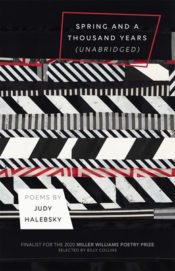 Judy Halebsky
Judy Halebsky
University of Arkansas Press ($17.95)
by Lee Rossi
Poet Judy Halebsky spent five years in Japan studying the theatrical and dance forms Noh and Butoh, an experience that informs her third book, Spring and a Thousand Years (Unabridged). Charming, self-effacing, and deeply reverent of Tang and Heian poetry, she offers a contemporary take on a world and world-view that flourished more than a thousand years ago.
Li Bai, aka Li Bo, aka Li Po, born in 701, is perhaps the most important presence haunting this book. We meet him in “Between Jenner and a Pay Phone” through the narrator’s direct address when she observes, “Li Bai, the shadows tonight are from street lights,” not the moon. Like him she is preparing for a life of austere simplicity as an artistic hermit: “I cut my hair flat against my forehead . . . / from now on: / only practical clothing / only blank pages.” Sometimes the writing is austere as well, borrowing images and tone from the Tang and Heian poets Halebsky so admires. But the overall effect of Halebsky’s work is warm and inviting, laced with humor and intelligence.
Li Bai is often a spokesman for Halebsky’s reservations about American life and culture. In “The Sky of Wu,” we encounter Li Bai, Du Fu, and the narrator hanging out together during a poetry workshop:
Du Fu is smoking an e-cigarette. Li Bai is laughing at him. They want to meet Charles Wright but I don’t have his number.
We don’t write the poems together, I explain, we just talk about them
Li Bai rolls his eyes
America, he says, it’s worse than I thought
This is the same character, who, in “Li Bai Considers Online Dating,” composes a “note to self: before writing profile, eat cookies / then resolve to lose weight, then drink beer.” Halebsky’s Li Bai might be an early incarnation of Walt Whitman: contradicting himself, containing multitudes.
One blurb calls this volume “a translator’s notebook,” but while it’s true that Halebsky has done frequent translations—from 2009 to 2011 she co-edited the bilingual poetry journal Eki Mae (In Front of the Station)—the “translator” in this volume is just one of several masks worn by the poet, a ploy we might expect from someone versed in Noh drama. “Poet,” “girlfriend,” and “naive American” are other masks, equally revelatory, equally reticent. A translator is charged with faithfulness to the spirit of a text, to the spirit of the author. Halebsky is less interested in reproducing texts than in reproducing their spirit in her own work. What better way to be faithful than to adopt the sly indirectness of her favorite authors, their focus on insight and truth, on the essential?
Not surprisingly, Halebsky, a poet with a postmodern sensibility, finds echoes of that sensibility in much earlier poets. In their company she is able to indulge her love of disjunction, seeming contradiction, and the incommensurate. Her own anything-but-elegant life is a declaration on behalf of hermit poets everywhere and a gentle rebuke to court ladies. The Pillow Book, perhaps the most famous book from Japan’s Heian period, was a private affair, a series of miscellaneous lists drawn from daily life at court, intended only for its author, Sei Shonagon. Like its inspiration, Spring and a Thousand Years (Unabridged) attempts to capture the ephemera and the ephemerality of life, even the most comfortable of lives.
This approach can be seen in “Glossary”—the title alluding, of course, to the mechanisms of translation—which offers a series of short, haiku-like poems, disguised as a guide to understanding:
Geographic Distribution—Range, wingspan, shade cast by tree branches, how to count whales, bird habitat, air temperature, ice floe, polar, panda, grizzly.
How do we read this list? What is its arc? Are we to feel a certain unease, as we scan the melting polar ice and visit those vanishing species? Perhaps because we in the U.S. may be reluctant to look beneath the surface, the poet helps us with a note: “This is a record of what is living now. In the future, it will serve as a historical record.” The almost offhand tone of that last sentence cannot obscure its anguish and regret.
Yet while Halebsky visits the past, she is not trapped in it; as a poet she is alive to ways that language renews itself. In “Addendum: Fifth Moon,” she notes: “these words are thousands of years old,” and yet they keep finding new ways to combine: “concrete streets with tires, a hydro river dam, legions of kung fu seven-year-olds with analog synthesizers, a ukulele revival, and a phone that can name constellations of stars.” The poet is also at times wryly personal, as in another entry in “Glossary” (“Height”) where she tells her lover, “I wish you were one foot shorter so we could talk easier standing up. And so I wouldn’t feel like a tiny person from a different tribe, one of grandmothers and twelve-year-olds, the undernourished, gymnasts, girl twins, snow men.”
Spring and a Thousand Years (Unabridged) is an invigorating book, offering readers not just the pleasures of the imagination but also a way to avoid the spiritual poverty which afflicts so many modern lives. Halebesky approaches contemporary disasters (climate change, post-industrial surfeit) with insight and unflinching strength; she confronts her own time with a stoicism learned from an earlier time, when self-abnegation, simplicity, and discipline provided a path to freedom.
